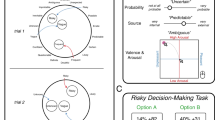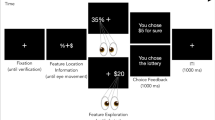Abstract
Uncertainty of outcomes is a primary dimension underlying human judgment and decision making, and is a defining feature of risk. Even though uncertainty almost always exists in decision making contexts, individuals and cultures vary in their preference for avoiding uncertainty. This study examines how uncertainty avoidance influences judgments involving uncertain and risky alternatives. Participants were presented with problems that involve potential gains or losses and contain options reflecting uncertain or certain outcomes. Greater uncertainty avoidance predicted choices for uncertain outcomes that involved gains, which tend to promote risk aversion, but not for uncertain outcomes that led to losses, which tend to promote risk seeking. These results demonstrate that culturally-relevant dispositions such as uncertain avoidance can have complex effects on judgment.
Similar content being viewed by others
References
Grecko, V., & Roger, D. (2001). Coping with uncertainty: the construction and validation of a new measure. Personality and Individual Differences, 31, 519–534.
Hastie, R., & Dawes, R. M. (2001). Rational choice in an uncertain world: The psychology of judgment and decision making. Thousand Oaks: Sage Publications.
Hofstede, G. (1980). Culture’s consequences. Beverly Hills: Sage Publications.
Hofstede, G. (2001). Culture’s consequences (2nd ed.). Thousand Oaks: Sage Publications.
Hong, Y., Benet-Martinez, V., Chiu, C., & Morris, M. W. (2003). Boundaries of cultural influence: construct activation as a mechanism for cultural differences in social perception. Journal of Cross-Cultural Psychology, 34, 453–464.
Javidan, M., House, R. J., & Dorfman, P. W. (2004). A nontechnical summary of GLOBE findings. In R. J. House, P. J. Hanges, M. Javidan, P. W. Dorfman & V. Gupta (Eds.), Culture, leadership, and organizations: The GLOBE study of 62 societies (pp. 39–48). Thousand Oaks: Sage Publications.
Kahneman, D., & Tversky, A. (1979). Prospect theory: an analysis of decision under risk. Econometrica, 47, 263–291.
Kahneman, D., & Tversky, A. (1984). Choices, values, and frames. American Psychologist, 39, 341–350.
Kemelmeier, M., & Cheng, B. Y. (2004). Language and self-construal priming: a replication and extension in a Hong Kong sample. Journal of Cross-Cultural Psychology, 35, 705–712.
Lau, L., & Ranyard, R. (2005). Chinese and English probabilistic thinking and risk taking in gambling. Journal of Cross-Cultural Psychology, 36, 621–627.
Lejuez, C. W., Read, J. P., Kahler, C. W., Richards, J. B., Ramsey, S. E., Stuart, G. L., et al. (2002). Evaluation of a behavioral measure of risk taking: the balloon analogue risk task (BART). Journal of Experimental Psychology: Applied, 8, 75–84.
Markus, H. R., & Hamedani, M. G. (2007). Sociocultural psychology: The dynamic interdependence among self systems and social systems. In S. Kitayama & D. Cohen (Eds.), Handbook of cultural psychology (pp. 3–39). New York: Guilford.
Matsumoto, D., & Yoo, S. H. (2006). Toward a new generation of cross-cultural research. Perspectives on Psychological Science, 1, 234–250.
Miyamoto, Y., Nisbett, R. E., & Masuda, T. (2006). Culture and the physical environment: holistic versus analytical perceptual affordances. Psychological Science, 17, 113–119.
Nisbett, R. (2003). The geography of thought: How Asians and Westerners think differently…and why. New York: Free.
Plous, S. (1993). The psychology of judgment and decision making. New York: McGraw-Hill.
Slovic, P., Fischhoff, B., & Lichtenstein, S. (1982). Response mode, faming, and information-processing effects in risk assessment. In R. M. Hogarth (Ed.), New directions for methodology of social and behavioral science: Question framing and response consistency (No. 11). San Francisco: Jossey-Bass.
Sorrentino, R. M., Smithson, M., Hodson, G., Roney, C. J. R., & Walker, A. M. (2003). The theory of uncertainty orientation: a mathematical reformulation. Journal of Mathematical Psychology, 47, 132–149.
Triandis, H. C. (2001). Individualism and collectivism: Past, present, and future. In D. Matsumoto (Ed.), The handbook of culture and psychology. New York: Oxford University Press.
Tversky, A., & Kahneman, D. (1981). The framing of decisions and the psychology of choice. Science, 211, 453–458.
Acknowledgements
This research was supported by grants awarded to the second author from the National Science Foundation (BCS 0721796) and the USDA Cooperative State Research, Education, and Extension Service. We thank Martin Coleman, Dana Wallace, and Renee Magnan for comments on earlier drafts of the manuscript. Portions of these results were presented at the 9th annual meeting of the Society for Personality and Social Psychology, Albuquerque, NM.
Author information
Authors and Affiliations
Corresponding author
Rights and permissions
About this article
Cite this article
Ladbury, J.L., Hinsz, V.B. Uncertainty Avoidance Influences Choices for Potential Gains but not Losses. Curr Psychol 28, 187–193 (2009). https://doi.org/10.1007/s12144-009-9056-z
Published:
Issue Date:
DOI: https://doi.org/10.1007/s12144-009-9056-z




